By Arnold Blumberg
At 4 am on October 14, 1806, 37-year-old Jean Lannes, Marshal of France in Napoleon Bonaparte’s Grande Armee and commander of that host’s V Corps, received his final instructions verbally from the emperor. The early part of the night had been clear with a slight frost, but toward dawn there descended a mist so thick that it was impossible to see more than a few yards distant. Two hours later daylight was scarcely perceptible as Lannes and his officers shifted their men from their cramped positions atop the Landgrafenberg Heights and deployed them into assault columns and firing lines covered by swarms of light infantry serving as skirmishers.
As the French line infantrymen hastened to widen their front and assume their assault formations, Napoleon, riding among Lannes’s soldiers on the front lines, addressed them in groups and individually, stoking their martial enthusiasm for the coming fight. He told them that the enemy was cut off and was struggling, not for victory, but for mere existence. His words were received by the troops with wild cheers and cries of “En avant!”
Thus, the V Corps and other corps in Napoleon’s Grande Armee prepared during the predawn light to meet the Prussian Army, the army of Frederick the Great, reputed to be the best in Europe, in a titanic struggle.
Despite his stunning triumph at the Battle of Austerlitz on December 2, 1805, which resulted in the breakup of the Third Coalition against him, Napoleon could not coax Russia into making peace. France’s implacable foe England, secure in its absolute control of the sea, waited in the wings seeking the opportunity to use its money to form yet another anti-French alliance. That chance materialized in 1806.
The linchpin of any future attempt to overthrow Napoleon’s control of Western Europe had to be Prussia. As 1806 progressed, that kingdom edged closer to joining Russia and England in a crusade against Imperial France as a result of the latter’s attempt to squeeze every advantage out of its recent trouncing of the Third Coalition.
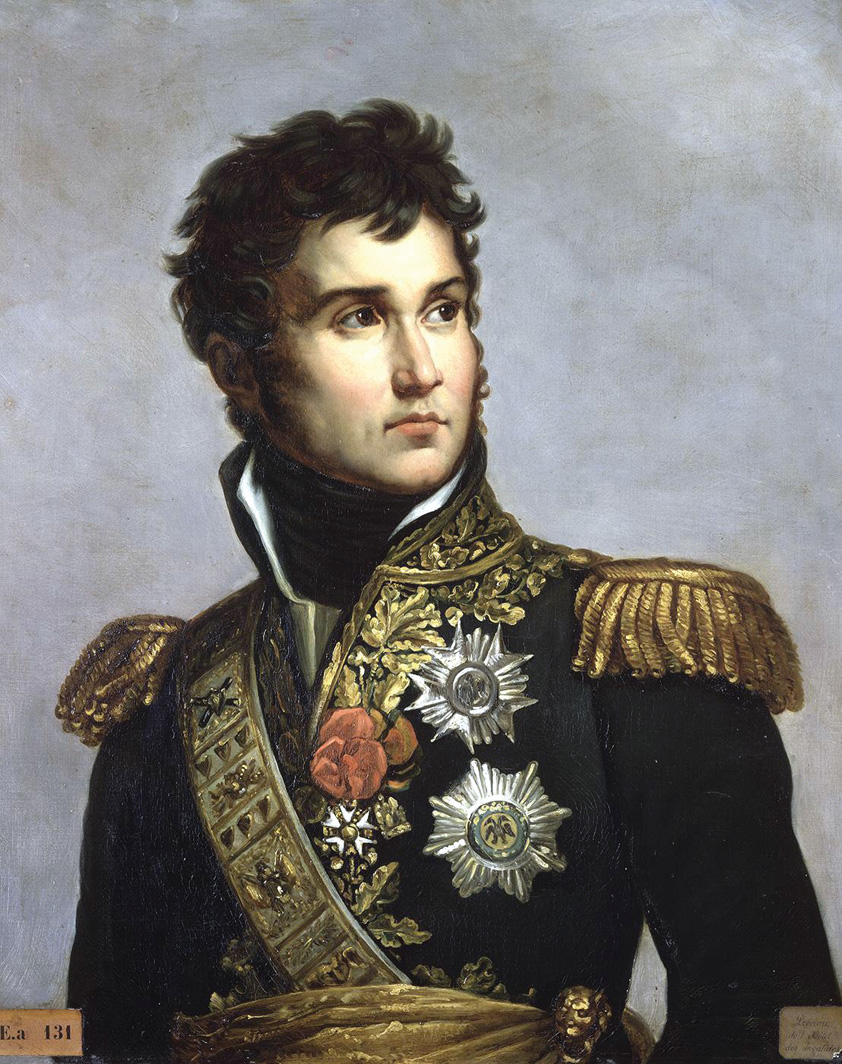
During the last critical months of 1805, there had been a real possibility that Prussia’s King Frederick-William III would throw his 225,000-man army into the fight against Napoleon. After Austerlitz, with Austria prostrate and Russia at a safe distance, Napoleon took possession of Prussia’s prized principalities of Cleves, Ansbach, and Neuchatel. In return, Prussia received the British possession of Hanover. To make matters worse for the Hohenzollern realm, Napoleon reordered Germany, creating a French-controlled Confederation of the Rhine, further isolating and humiliating Prussia. The final straw came when Napoleon, to make peace with England and without the slightest notice to or regard for Prussia, offered to give back Hanover to England. On August 10, the Prussian Army was mobilized, Saxony was occupied to keep that state out of the Confederation of the Rhine, and the government accelerated its search for allies. It was not until September 15 that the French understood the seriousness of the situation and began their own preparations for war.
As the Prussian high command plotted the best course to defeat Napoleon in the upcoming campaign, a glaring weakness appeared. The Prussian Royal Army’s lack of a centralized command system was of great concern. Namely, the Prussians did not have a skilled staff to coordinate the movement of men and supplies in a rapid and orderly manner designed to cope with the fast-paced operations at which the armies of Napoleonic France were so adept. Further, there was no unified command and control by which to direct the Prussian Army’s activities. Instead, the command structure was made up of a group of discordant elderly senior officers in constant rivalry with each other. As a result, the army would perform on a spur of the moment basis marked by spasmodic maneuvers much of the time and unable to keep up with the ever changing operational realities on the ground. This led to much of the confusion and indecisiveness so marked by the actions of the army high command during the war.
However, at the outset the high command agreed that Napoleon’s Grande Armee was spread over a wide area in central Germany. A surprise attack on it, so as to beat it in detail before it could concentrate, was the most logical course. Even this common sense approach was severely handicapped by the lack of a comprehensive prewar contingency plan to conduct operations against France. As one staff officer lamented at the time, “What we ought to do I know right well; what we shall do only the gods know.”
It took a month of bickering between the top Prussian generals to finally arrive at a force structure with which to initiate the war. Eventually three field armies were mobilized. The first, under the 71-year-old Charles William Ferdinand, Duke of Brunswick, was assembled near Berlin and numbered 75,000 men. The second was commanded by Prince Friedrich Ludwig von Hohenlohe, aged 60 years, initially 42,000 strong (including the 18,000-man Saxon Army) mustered at Dresden. The third, jointly led by the relatively young General Ernest Philipp Ruchel, at 52, and the 64-year-old fire brand Lt. Gen. Gebhard Leberecht Blucher, was posted in the Mulhausen-Gottingen area with 29,000 soldiers. A 13,000-man reserve under Eugen of Wurttenburg was at Magdeburg, ready to merge with Brunswick at either Leipzig or Naumburg. Off to the east, at Posen (in modern Poland) was a field force of 25,000 led by 68-year-old Prussian Lt. Gen. Anton Wilhelm von Lestocq.
Five operational plans were put forth and hotly debated before the decision was made to adopt the one suggested by Brunswick. This sensible scheme called for the Prussians to await the arrival of the Russian army (120,000 strong) then gathering on the River Bug. It further mandated that if Napoleon took the offensive before the Prussians and the czar’s forces combined, the Prussian Army would retreat to the River Elbe, or in the extreme case to the Oder, to join up with the Russians.
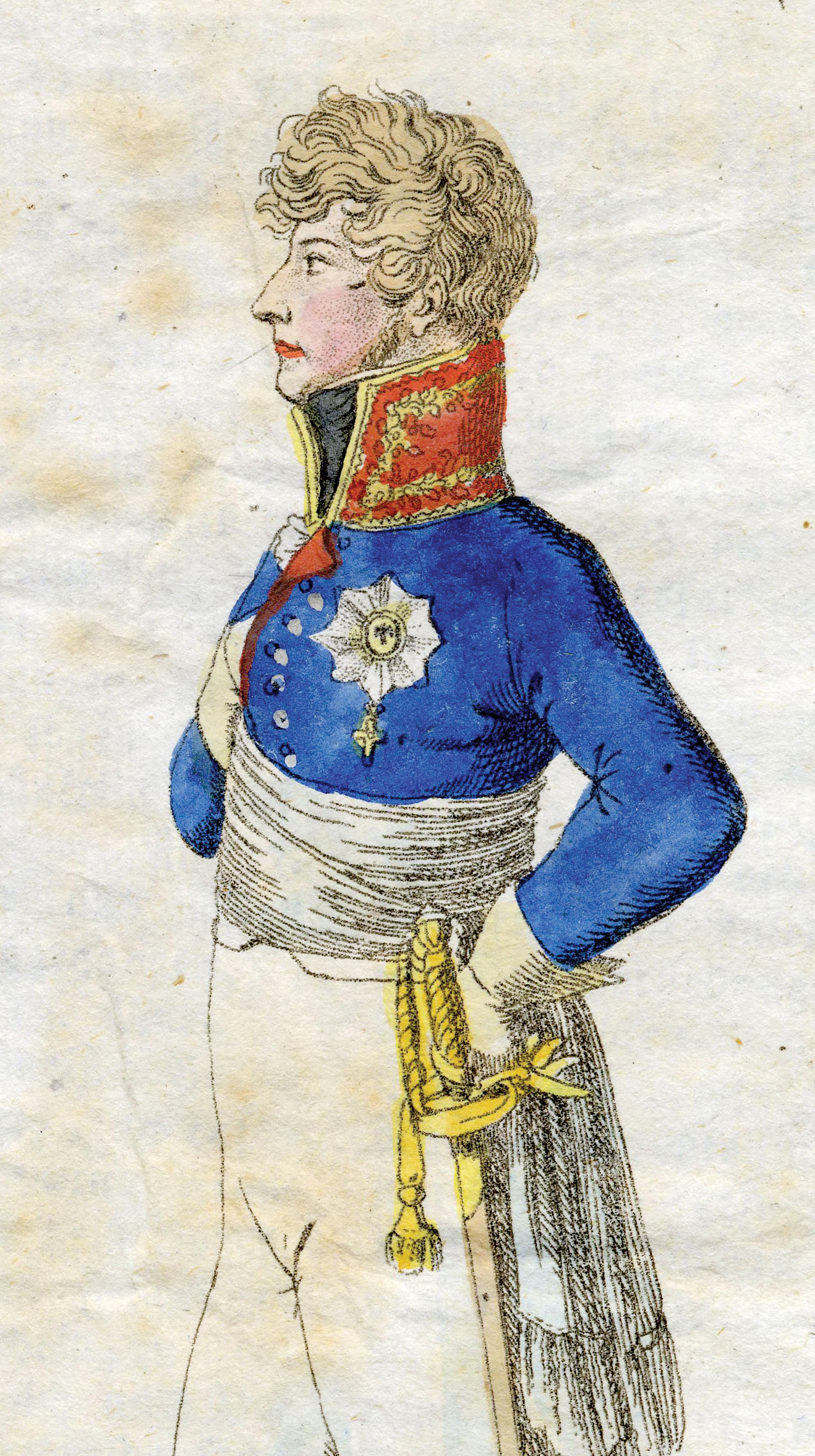
Having finally arrived at a plan of action and a chaotic start to its implementation, the whole design had to be scrapped when on October 5 the Prussian commanders were informed that the French were already on the move with the intention of invading Saxony. Forced by their enemy assuming the initiative, the Prussians reacted by ordering their forces to mass west of the River Saale to threaten the French left flank as the latter advanced.
As the Prussians mobilized their rusty, outdated war machine and wavered indecisively as to how to fight a war against Napoleon, the French emperor was already on the move. Determined to preempt his new opponent, the emperor devised a campaign that would see him concentrate his Grande Armee in the area of Wurzburg and Bamberg, then advance northeast toward Leipzig and then Berlin. The advantages of this plan were that the French Army in September was already well placed for such a move and that it would drive a salient between the Prussians and the Russians forming to the east. The disadvantages involved passage through the rough terrain of the Thuringerwald Forest over its three available passes; but once through those choke points, the Rivers Saale and Elster would protect the French flanks.
While Napoleon, as he wrote his brother Louis Bonaparte, King of Holland, planned to “leap into the center of Prussia with my army, marching directly on Berlin,” Louis was to amass 30,000 troops and threaten Prussian territory from Wesel on the River Rhine as a diversion. In the meantime, the Army of Italy was reinforced to keep an eye on Austria, while 26,000 men were mobilized in and around Paris to counter any British advance across the English Channel.
The French campaign swung into action on October 8. Preceded by light cavalry, three powerful columns entered Saxony heading for the three Thuringerwald defiles. On the left, Marshal Jean Lannes’s V Army Corps, followed by Marshal Pierre Francois Charles Augereau’s VII Corps, totaling 41,000 men, set out from the city of Schweinfurt and headed for Saalfeld. In the center, Marshal Joachim Murat’s three-division cavalry corps and Marshal Jean-Baptiste Jules Bernadotte and his I Corps, acting as the advance guard, were trailed by Marshal Louis Nicholas Davout’s III Corps, General Louis Michel Antoine Sachu’s 4th Dragoon Division, and the Imperial Guard Corps (totaling 70,000 troops), with Napoleon and his headquarters bringing up the rear, all moving toward Naumburg. On the right, emerging from the town of Bayreuth, tramped Marshal Nicolas Jean de Dieu Soult’s IV Corps, followed by Marshal Michel Ney and his VI Corps, and then the Bavarian Corps. These 50,000 men were aiming for Hof and then Gera on the River Elster.
On the same day the French made their opening move of the campaign, the Prussian forces were situated as follows: the Duke of Weimar, commanding the advance guard, was scouting toward Schweinfurt; General Ruchel was at Eisenach; Brunswick and the main army were covering the Gotha-Erfurt area; and Hohenlohe’s command was scattered over a wide area west of the River Saale. Hohenlohe foolishly placed several large detachments, including Prince Louis of Prussia, near Saalfeld and a corps led by General Bolesas Friedrich Emanuel Tauenzien at Schleiz southeast of Saalfeld, essentially isolated east of the Saale. Finally, Wurttemberg moved from Magdeburg to Halle. At this point the Prussians still had no clear plan of action, and what the Prussians came to call “Die Katastrophe von 1806” was about to befall them.
Confident that the enemy was not holding all three exits to the passes through the Thuringenwald, Napoleon sent his army into the forest. The first real opposition was encountered October 9 when Bernadotte and Murat ran into Tauenzien’s 9,000 men (6,000 Prussians and 3,000 Saxons) isolated at the village of Shleiz. A brief but sharp action soon cleared the enemy from the French line of advance, and within 72 hours of the start of its movement the Grande Armee was safely through the Thuringerwald.
Upon hearing of Tauenzien’s reverse, Brunswick and Hohenlohe played with the idea of crossing to the east bank of the Saale to come to Tauenzien’s aid near the village of Auma. However, this scheme was dropped when Tauenzien elected to remain on the west shore of the river.
On the morning of October 10, Marshal Lannes, riding with the van of the left French column, neared the town of Saalfeld. Defending the place was a mixed Prussian and Saxon division, the advance guard of Hohenlohe’s army, 10 squadrons of cavalry, 10 infantry battalions, and 44 pieces of artillery (about 8,300 men) of Prince Louis. Formally known as Ferdinand Ludwig Christian, Prince of Prussia, Prince Louis was a nephew of the late King Frederick the Great, a combat veteran of the French Revolutionary Wars, and a fervent supporter of the war against France. On October 9, under the conviction that he was to protect from Lannes’s advance Hohenlohe and Brunswick’s proposed crossing to the east side of the Saale, he occupied Saalfeld, reaching that place the next day. Then, late on the morning of October 10, the 34-year-old warrior was ordered to abandon his exposed position, but the instructions arrived after the fight for Saalfeld had been joined.
The prince formed his detachment into three lines, one behind the other, in a flat unobstructed valley facing wooded slopes from which the French would have to debouche if they were to attack his position. To the Prussians’ rear was the River Saale with the bridges at Saalfeld and Schwarza (the latter more than two miles north of Saalfeld) the only means of escaping over the river. The prince knew that any enemy force leaving those woods would have to move in column to clear the timber-strewn area leading down to the valley. The open plain that his command stood on not only gave it a clear field of fire, but provided suitable ground over which to launch effective counterattacks before the enemy could deploy into line of battle.
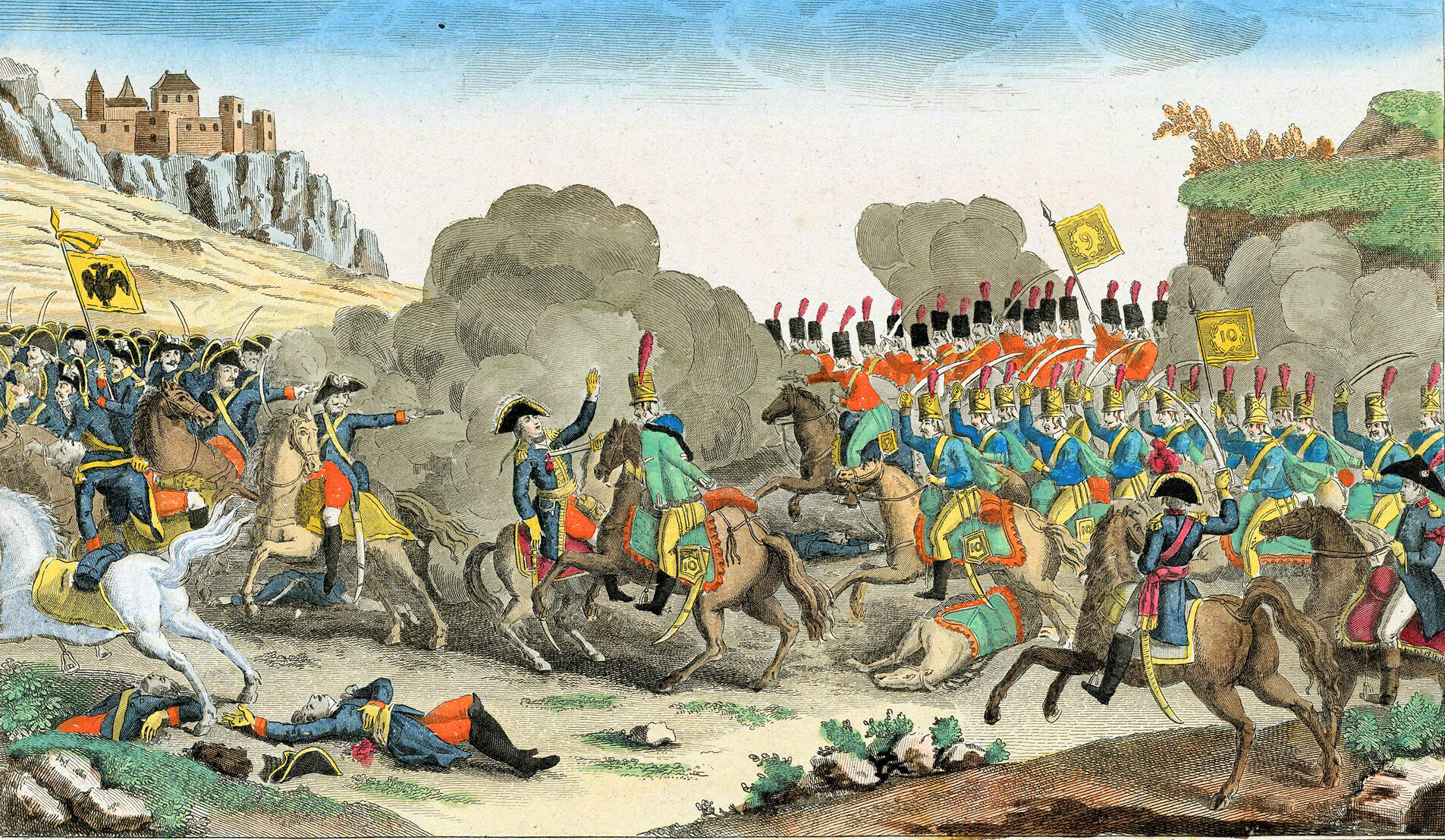
Upon viewing the Prussian deployment, Lannes determined to assail the enemy’s right flank over hilly ground but hidden from the enemy’s view. He used General Louis Grabriel Suchet’s 1st Infantry Division, V Corps, and the corps’ attached cavalry brigade to deliver the intended blow.
Before the main assault, to avoid his attack columns being struck by the Prussians as they advanced down into the valley from the wooded slopes, the marshal spread a line of skirmishers, supported by cavalry and artillery, along much of the enemy front. This advance guard tied down the Prussian main line, preventing it from either advancing against the French as they deployed for the assault or reinforcing their right flank (the objective of the French attack) and cutting Prince Louis’s detachment off from its escape route over the Saale at Schwarza. The Prussians experienced substantial frustration and danger in the open with their backs to the river over the next two hours, from 11 am to 1 pm. “Enemy skirmishers, themselves under perfect cover could easily pick out any one of us, without it possible to return fire on invisible men,” wrote Captain Mumpfling, a Saxon officer serving with Prince Louis’s command.
As the prince’s troops stood helplessly under the withering fire of the French skirmishers, Louis was forced to thin out his already slender line by detaching several battalions and artillery batteries to occupy Schwarza and the hills commanding that place, leaving only two infantry battalions and 12 pieces of artillery to hold Saalfeld. He was also instructed not to attack the enemy but to stand fast since Hohenlohe’s army was coming to the Saale to join him, but the brave and enterprising young general soon disregarded his superior’s orders.
Stung by the unrelenting enemy skirmish fire coming from the orchards, gardens, and sunken roads surrounding the villages facing him, Louis initiated an attack against his tormentors at 1 pm. With six battalions (four in the first line, two in the second), and without any artillery support or reconnaissance to determine his opponent’s exact numbers or dispositions, he rashly made a frontal assault. The Prussian lunge was immediately struck on its right by fire from clouds of French skirmishers in hidden locations. The enemy shooting caused the Prussian line to waver, stop, and deliver several ineffective musket volleys. Then it was hit on its right by two infantry battalions, forcing a withdrawal of the entire line. After a short pursuit the French were in turn made to retire after being counterattacked by the reformed Prussians.
As the initial clash died down, at 2 pm Lannes pushed forward his own attack force, about 14,000 men. This first rush caught his opponent on his left and resulted in not only forcing him to retreat but the capture of 15 enemy artillery pieces. An hour later the French concluded the action with an avalanche of infantry and cavalry columns descending upon the front and right of the now weakened and disorganized Prussians. Seeing his infantry falling back while being cut to pieces by enemy musketry and sabered by French cavalry, Prince Louis gathered the few friendly horsemen available and charged into the melee to help cover the retreat of his command. It was during this desperate act that the prince was cut down and killed in hand-to-hand combat by Quartermaster Guindet of the French 10th Hussar Regiment.
As the main Prussian line dissolved and fled to the west bank of the Saale, the French stormed and took the village of Saalfeld. By the end of the engagement, Lannes had established bridgeheads across the river and had killed, wounded, or captured 3,000 Prussians and taken 27 artillery pieces. Fifth Corps losses from all causes were reported as only 172 soldiers.
Their loss at Saalfeld, the first major combat of the war, along with the death of Prince Louis, greatly demoralized the Prussian Army. It appeared that the enemy was going to break through toward Leipzig, thus threatening Prussian communications. Reacting to this almost certain possibility, Hohenlohe ordered a retreat of his forces west of the Saale toward Jena, while Brunswick’s army concentrated at the city of Weimar.
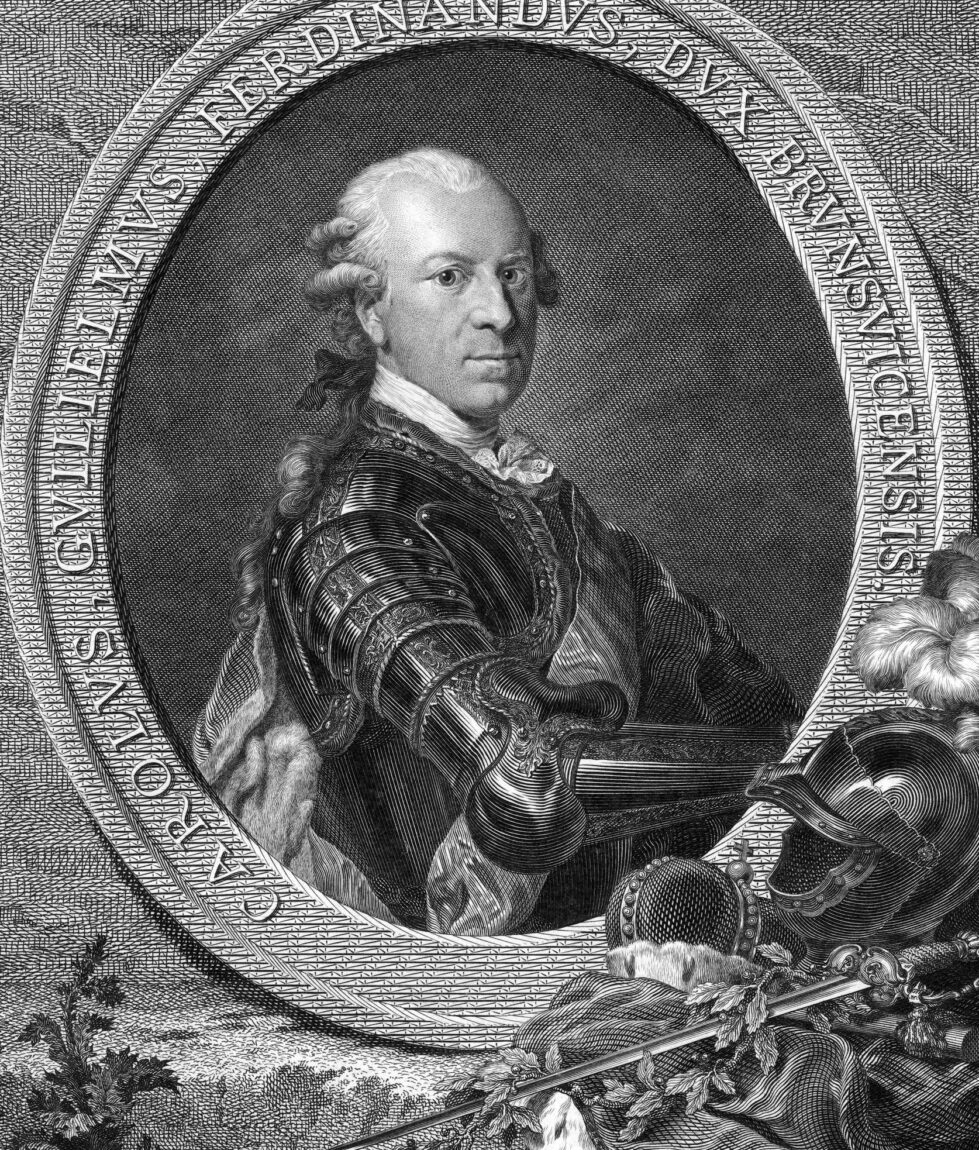
As the Prussians drew back west and north of the River Saale, Napoleon at first surmised from reports that they were going to concentrate just south of Leipzig. Sensing an opportunity to catch the enemy and attack them piecemeal as they began to assemble near Leipzig, Napoleon directed his Grande Armee to that point. On October 11, the emperor received intelligence from his corps commanders that the Prussian Army was not congregating around Leipzig to protect its communications with that town, but that its main body was still situated farther to the west and that Brunswick would offer battle near the city of Erfurt.
Responding to this clarified picture of his opponent’s intentions, Napoleon ordered the Grande Armee to wheel to the left to confront the foe and prevent his escape to the River Elbe and a junction with the Russians. Accordingly, Lannes’s and Augereau’s corps became the new advance guard for the army and made for the Saale crossing places at the towns of Jena and Kahla, while Davout, Bernadotte, and Murat’s commands occupied the area around Naumburg, which was situated southwest of Leipzig, ready to support the army’s advance guard. Soult was detached to the east bank of the Saale to watch the north and east just in case the enemy made an appearance in that direction, while Ney’s corps was sent trailing after Lannes’s troops.
Napoleon’s intent at this moment was to pass over the Saale on October 14, move on Weimar, and attack Brunswick in the vicinity of Erfurt on October 16. He calculated that the Prussian commander had two options. One option was to accept battle before Erfurt. If that occurred, the French V, VI, and VII Corps would fix the enemy frontally while the I and III Corps swept down from the north against the foe’s left and rear. Another option was to attempt to flee toward Halle (where the Prussian reserve was still located), then to Magdeburg, and then to the relative safety of the right bank of the Elbe. To counter this second option, the majority of the Grande Armee would pursue through Jena, while Davout and Bernadotte headed the Prussians off from the Elbe, thus forcing them to fight.
As the French planned their next moves, the Prussians were on the march. On October 11, Brunswick retired on Jena, evacuating that place the next day but not before his reluctant Saxon allies panicked on the approach of Lannes from the southwest. It took 24 hours to bring the Saxons back under control. On October 13, with both their options and the space for maneuver narrowing, a council of war was convened by King Frederick William. It was decided to head east to the Elbe by way of Leipzig-Auerstedt-Halle. There was now no thought of facing Napoleon in pitched battle; Brunswick was determined to avoid that possibility no matter what. The Prussians’ smug confidence of September had given way to near panic in October.
As the morning of October 13 wore on, information coming to Napoleon convinced him that his opponent was about to move east over the Saale. He wrote to his cavalry leader Murat at 9 am stating: “At last the veil is lifted. The enemy begins his retreat toward Magdeburg.” By mid-afternoon, the emperor was on his way to Jena when he got word from Lannes, then positioned on the west bank of the Saale near the Landgrafenberg Heights just short of Jena, that about 50,000 Prussian soldiers were at or near Jena. Sensing Brunswick meant to attack Lannes at any moment (Hohenlohe in fact intended to do so that morning but cancelled the venture when he was informed of the planned Prussian retreat to Leipzig), Napoleon determined to preempt him by making an attack on the Prussians first. Meanwhile, Napoleon, erroneously thinking that Lannes, with only about 25,000 men, was facing the main Prussian army (in fact only the Prussian right wing was present), ordered the marshal to reinforce the Landgrafenberg bridgehead and take control of its high ground while he ordered reinforcements to come to V Corps’ aid. He estimated that by late afternoon on October 14, he would have 145,000 men to fight his battle at Jena.
While Napoleon, on October 13, assumed he was facing the entire Prussian Army before Jena, the reality was far different. The larger portion, 60,000 troops, of Brunswick’s command had that morning been marching away from Jena toward Auerstedt. The enemy had divided its forces into two armies, and both were likely to make contact with different parts of the Grande Armee (the IV,V,VI, VII, Murat’s cavalry, and the Imperial Guard Corps outside Jena, and the I and III Corps near Auerstedt, 10 miles to the north) on October 14.
The French emperor was not the only one who misunderstood what he was facing on October 13. Hohenlohe thought that the enemy forces on the Landgrafenberg were a flank guard covering the main French forces heading for Leipzig. Both commanders were surprised by the events of October 14.
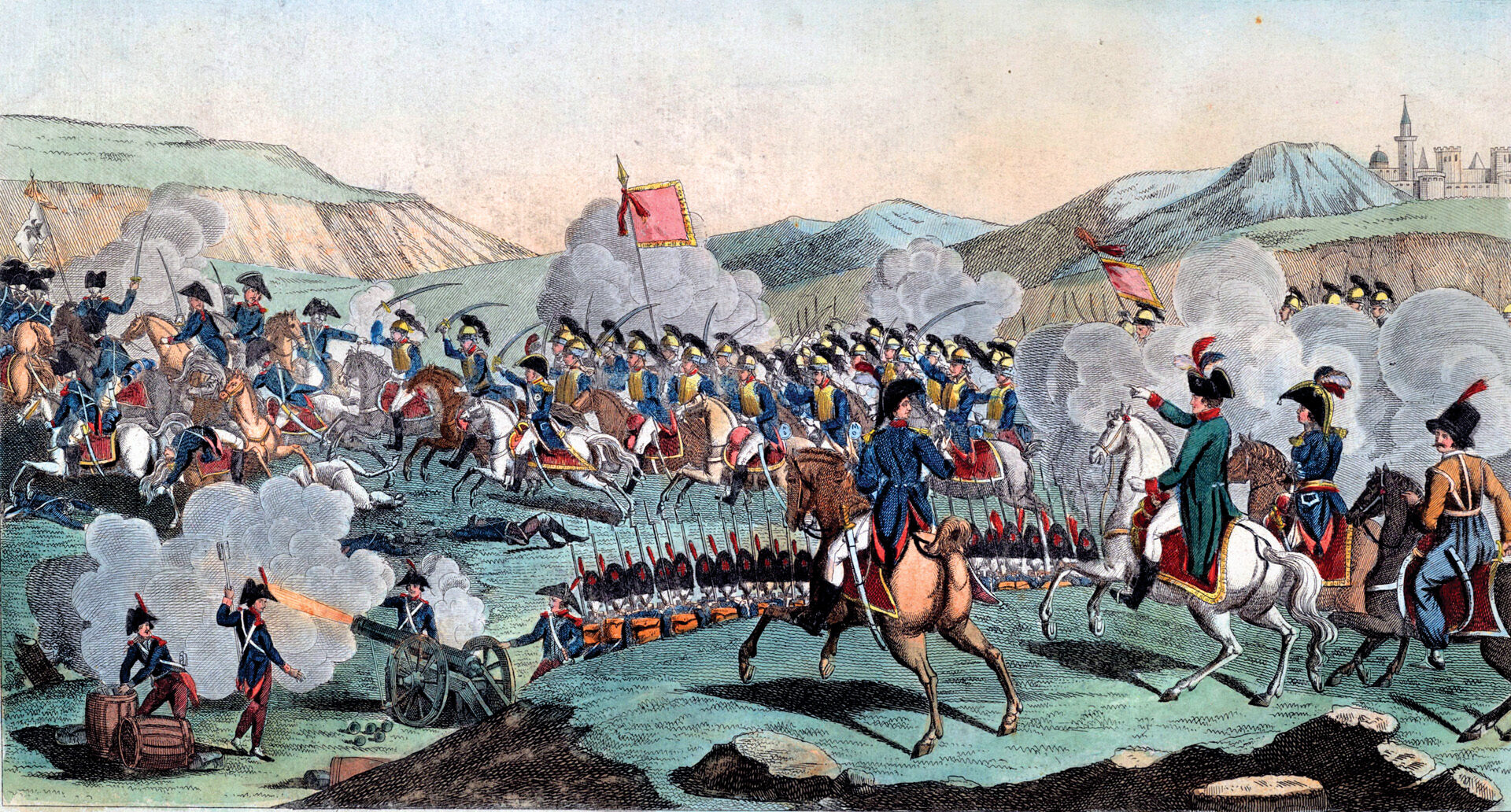
On the morning of October 14, the battlefield at Jena was shrouded in fog, which hampered Napoleon’s final reconnaissance. Nevertheless, by dawn 46,000 French troops supported by 70 cannons were massed on the Landgrafenberg Heights and in the neighboring valleys ready to advance. The Prussian force they confronted numbered about 38,000 men and 120 artillery pieces. Many of the Prussian battalions were understrength from straggling and desertion. All were hungry, and morale was at low ebb due to the obvious fear and indecision that had taken hold in the army’s high command.
The Battle of Jena began at 6 am as the corps of Lannes, Soult, and Augereau drove off Tauenzien’s advance guard to enlarge the French Landgrafenberg bridgehead on the west bank of the Saale and make room for the fast-approaching French reinforcements. As the infantry divisions of Suchet (on the right) and General Honore Theodore-Maxime Gazan (on the left), accompanied by 28 guns, crashed into Tauenzien’s battalions, a confused close-quarter battle in the fog ensued. Suchet made good headway, while Gazan was repulsed. Soon a Prussian counterattack was thrown back by devastating point-blank French artillery fire. Tauenzien, although things were not going that badly for him, fell back to the village of Vierehnheiligen. He then violently counterattacked the rapidly pursing enemy with 5,000 recently rallied friendly troops, not only forcing the French to retreat, but also splitting them in two north and south of Vierehnheiligen. Fortunately for Lannes, Tauenzien did not press his advantage but turned about and marched off to the west.
The Prussian retrograde was in part due to both the threat Soult presented to the Prussian left and Augereau’s advance on the right. Fearing his route of retreat toward Weimar was threatened, Tauenzien pulled back to the northwest to link up with Hohenlohe’s main body. The time was 10 am, and due to unnecessary timidity by his opponent Napoleon had secured the needed ground in which to deploy the ever increasing numbers of his Grande Armee. Having pushed back his foe, Napoleon ordered a pause in the center and on the left to properly position the newly arriving units.
However, fierce combat continued on the French right between Soult and Prussian Lt. Gen. Friedrich Jacob von Holtzendorff’s 5,000-man brigade coming west from Dornburg. Shortly after 10 pm, Holtzendorff’s skirmishers engaged Soult’s 1st Division, commanded by General Louis-Vincent-Joseph le Bond Saint Hilaire, while the bulk of the Prussians formed their infantry, cavalry, and 22 guns for an attack. However, Saint Hilaire did not wait to be assaulted. He sallied from his hidden position on a reverse slope and caught his adversary on his left flank. Forced to retire, Holtzendorff’s men at first made an orderly retreat covered by their cavalry. However, French riders broke through the Prussian mounted screen and destroyed one of the withdrawing Prussian infantry columns, capturing 400 men and six guns. Undaunted, the Prussian general rallied his men behind the village of Nerkwitz for another effort against the French. However, a second enemy infantry strike against his left combined with a frontal attack by French horsemen routed his command, which fled to Apolda, seven miles north of Jena. Thus the second phase of the battle petered out near 11 pm. Saint Hilaire did not have the opportunity to pursue his beaten foe, instead being called upon to respond to a crisis developing in the French center.
By 9 am, Prince Hohenlohe realized that he was not just facing an attack by an enemy flank detachment and that he had to shore up his defenses with additional troops. To that end he sent word to Ruchel at Weimar to join him. Tauenzien was instructed to withdraw his survivors to the rear of Hohenlohe’s position to reorganize, while three full Saxon brigades were stationed on the road to Weimar to keep that avenue free of the enemy. Next, Hohenlohe pushed eastward most of his remaining Prussian infantry along with a further Saxon brigade, under Lt. Gen. Julius von Grawert, to retake the French staging area on the plateau near the Landgrafenberg Heights. The third act of the Battle of Jena was about to open.
Grawert’s force approached the French in piecemeal fashion, the Saxon steering for the west bank of the Muhilbach stream followed by cavalry and horse artillery, and the Prussian infantry bringing up the rear. By late morning, 11 infantry battalions were facing Lannes’s corps. The Saxons supported the right while the cavalry came up. Then, unexpectedly, fighting erupted to the south of Vierzehnheiligen.
The action at Vierzehnheiligen was initiated by the advance guard (two light cavalry regiments and five infantry battalions) belonging to Marshal Ney’s VI Corps. Impatient to get into action, Ney, who had spent the morning near Jena waiting for the rest of his corps to appear, without orders moved the only troops he had—the advance guard—forward to the sound of the battle. Unseen by all parties due to the fog, Ney’s detachment inserted itself between Lannes’s left and Augereau’s right and made straight for a powerful enemy artillery battery. At first the newcomers’ boldness paid handsome dividends as the Prussian infantry opposing them collapsed even before first contact was made with the French, the battery’s gunners fled, and the 45 Prussian cavalry squadrons that were about to launch a charge on Lannes’s troops around Vierzehnheiligen hurriedly retreated.
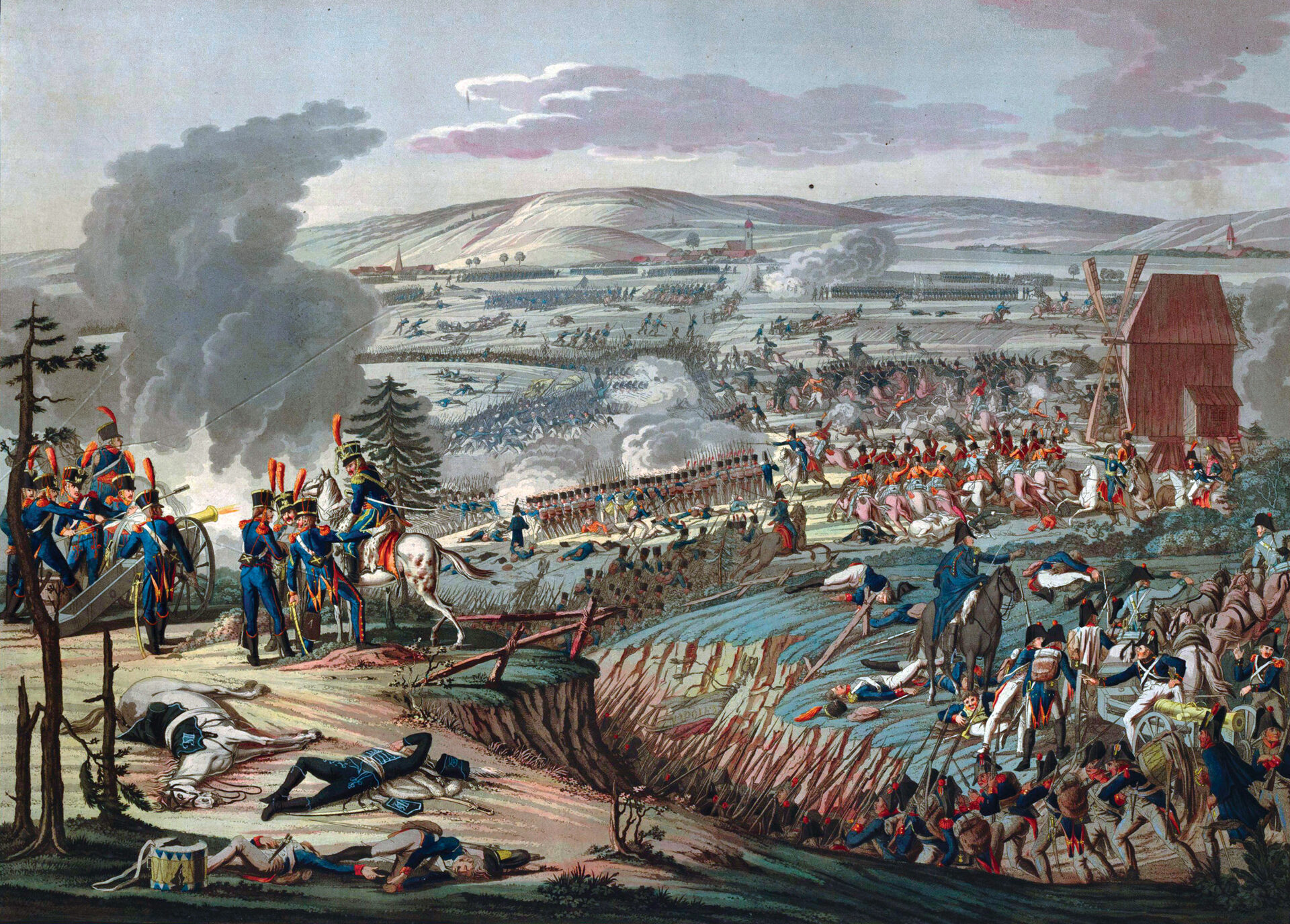
Ney and his men did not have much time to celebrate their astonishing success. Having outdistanced any possible support from Lannes and Augereau on either flank, Ney was vulnerable to a counterattack by the now recovered Prussian cavalry, which duly moved forward to do just that. The marshal placed his infantry in battalion squares with his cavalry in support to withstand the enemy onslaught. Regardless, Ney was now completely cut off from the rest of the army and facing annihilation.
Seeing the dire plight of his subordinate, Napoleon sent forward two cavalry regiments, the only remaining mounted reserve he had (Murat had not yet reached the field), to help ward off the enemy cavalry. In addition, the emperor directed Lannes to press forward through Vierzehnheiligen to link up with Ney’s isolated force while Augereau formed a battle line just to the rear of Ney. Although these moves relieved the pressure on Ney, they resulted in reverses for the French. Lannes’s move brought him into contact with the attacking battalions of Grawert, who repulsed the French advance. And without Lannes’s support, Ney was made to fall back.
With momentum on his side and with the real possibility of reclaiming the ground lost that morning, Hohenlohe was urged by his staff to storm Vierzehnheiligen. Instead, he halted Grawert’s movement to await the arrival of Ruchel’s corps from Weimar. For the next two hours Grawert’s 20,000 men stood within easy range of the French-occupied village all the while being peppered by French fire, causing heavy Prussian losses.
As the morning wore on, Lannes attempted to break the impasse by launching a flank attack against Hohenlohe’s left in combination with a frontal charge. At first successful, it was thrown back by newly arrived Saxon cavalry. Meanwhile, Hohenlohe’s right was assailed by Ney and part of Lannes’s corps which managed to strike the road to Weimar and cut off the three Saxon brigades guarding that route from the center of Hohenlohe’s main battle line. Reacting to this deepening crisis, the Prussian commander committed his last units to fill the gap between his right and center.
With about 96,000 men either committed to the fray or in ready reserve, at 1 pm Napoleon ordered a general advance against the enemy. The Prussian left was to be hit by Saint Hilaire’s division, the right by Augereau , while the center was assaulted by Ney and Lannes with Murat’s cavalry in support.
As the French steamroller moved forward, it penetrated gaps in the enemy line; Prussian fire slackened, and Hohenlohe ordered a retirement that was harassed by French artillery fire. At first the Prussian retreat was orderly, but as Murat’s horsemen thundered forward in pursuit the retreat disintegrated into a rout with part of the beaten army going toward Weimar to the west, the rest to the north. Tauenzien fell back in good order, keeping Soult at arm’s length.
Marching east along the Weimar Road to join the rest of Hohenlohe’s army during the mid-afternoon, Ruchel’s 15,000-man corps encountered the oncoming French. First the former moved into a defensive position but then decided to retreat. As it did so the effects of French cannon fire from a horse artillery battery and the appearance of French infantry caused Ruchel’s men to panic. Then a devastating charge by Murat’s cavalry squadrons broke all Prussian cohesion, making them flee toward Weimar. losing 4,000 prisoners in the process.
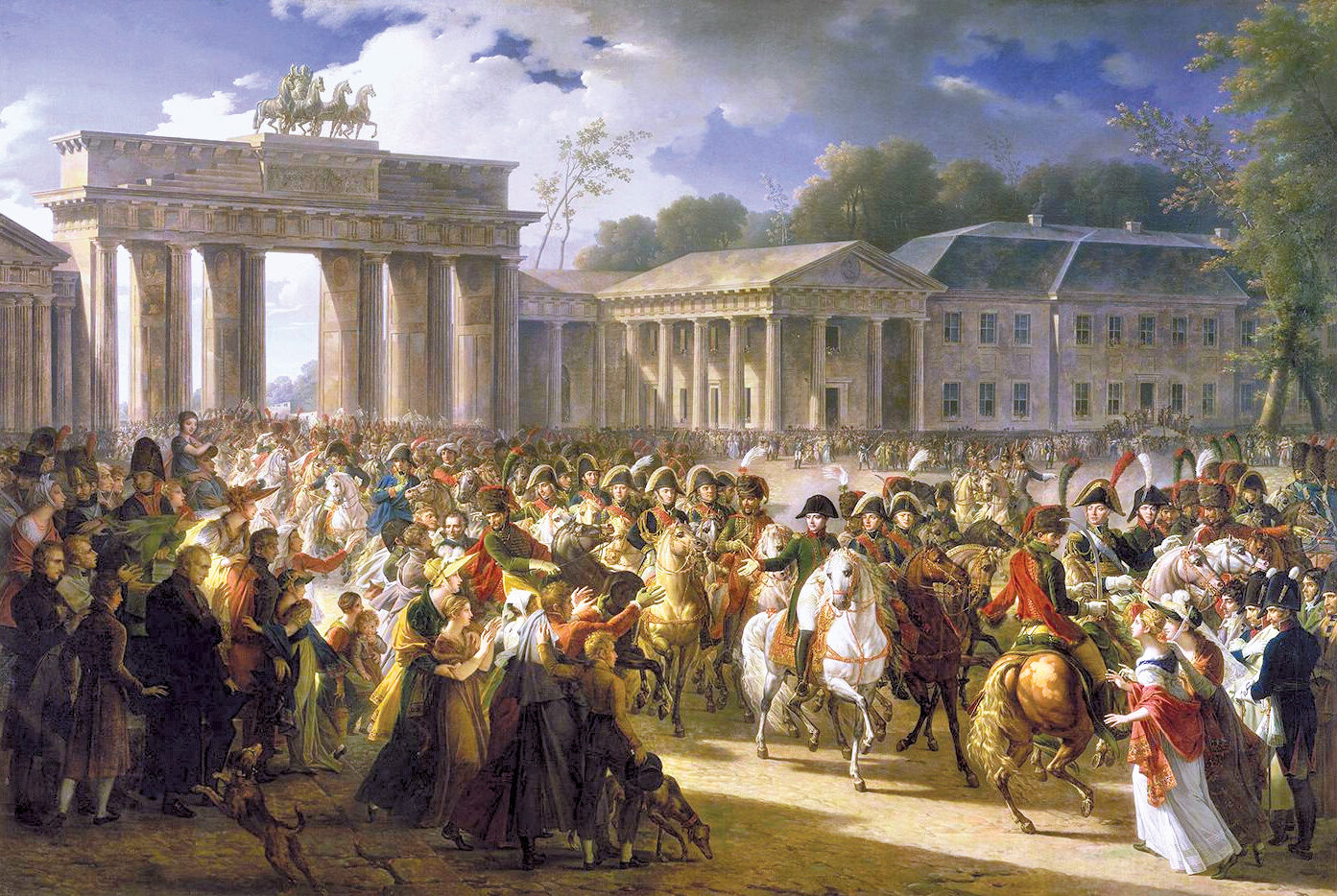
By 4 pm the Battle of Jena was over. The Prussian Army had suffered 10,000 killed and wounded and 15,000 taken prisoner, while the French endured 5,000 killed, wounded, and missing. While Napoleon was savoring his latest battlefield victory, he received the astonishing news that Marshal Davout, with his corps of 26,000 soldiers, had engaged and beaten the main Prussian army numbering 60,000 men and 230 guns at Auerstedt that same day.
In keeping with the emperor’s orders received at 4 am on October 14, Davout moved his corps west from Naumberg toward Apolda. A dense predawn fog hid the fact that the I and III Corps were heading into the bivouac area at Auerstedt that Brunswick had established for his army during the night of October 13. Learning that Davout was approaching his encampment, instead of attacking his enemy to clear a direct path east to Leipzig, Brunswick directed his command to move west to the Hassenhaussen Heights and then northeast to avoid contact with Davout. This maneuver was to be shielded by a mixed cavalry and infantry force under Lt. Gen. Friedrich Wilhelm Carl von Schmettau.
At 7 am on October 14, Davout, accompanying the III Corps division under Charles Etienne Gudin, was nearing the hamlet of Poppel. There Gudin took the precaution of forming his advance guard into squares. It was good that he did since he soon ran into an enemy cavalry detachment which he rapidly dispersed with musket fire. Advancing to the Liss Bach stream, Gudin halted intending to wait for the other III Corps infantry divisions (Generals Charles Antoine Louis Alexis Morand and Louis Friant) to close up. Morand and Friant were well to the east of Gudin and would take hours to reach him.
While Gudin suspended his forward movement, the Prussians, moving toward him from the south, assembled about 10,000 men (nine infantry battalions, 16 cavalry squadrons, and 24 guns) to attack Gudin’s 5,000 troops. Happily for the French, the initial enemy assault was uncoordinated with General Gebhard Blucher rushing his horsemen, unsupported, into Gudin’s battalion squares and being easily repulsed. By the time the Prussian attack was renewed with infantry, Friant’s division arrived at about 9:30 am and deployed on Gudin’s right. At the same time as Friant’s timely arrival, the III Corps’ 12-pounder artillery battery and its light cavalry brigade also appeared, the former massed to the north of Hassenhaussen. Sensing the enemy was going to attack his right flank, Davout pulled Gudin out of the village and stationed most of it to the north. One of Gudin’s regiments was placed south of the village.
When the Prussians attacked close to 10 am, with Schemettau on the left, Lt. Gen. Leopold Alexander von Wartensleben on the right, and Lt. Gen. William the Prince of Orange’s division behind them in support, the effort was met with varying fortunes. Schemettau’s men were mauled by the crossfire of the two French divisions. But von Wartensleben, attacking the lone French regiment to the south of Hassenhaussen, routed it easily, thus creating a serious threat to Davout’s left flank.
Regrouping behind the village, Davout retook it with a savage counterattack. Although stabilized for the moment, the French situation was getting more desperate by the minute since Morand was three miles away to the east and Bernadotte’s corps, which was supposed to be working in conjunction with Davout, was nowhere to be seen.
Fortunately for Davout, his opponent, instead of swinging around his exposed southern margin (30 Prussian cavalry squadrons were massed to do just that), disregarded his advantage and made four fruitless frontal attacks against Hassenhaussen. During one of these, the Duke of Brunswick, while leading a contingent of grenadiers in the assault, was shot through both eyes and mortally wounded. About the same time, Schemattau was put out of action by a battle wound. King Frederick William III failed to appoint a new commander-in-chief, which led to mounting confusion on the part of the remaining senior officers, preventing the implementation of a cohesive plan of action with which to continue the fight.
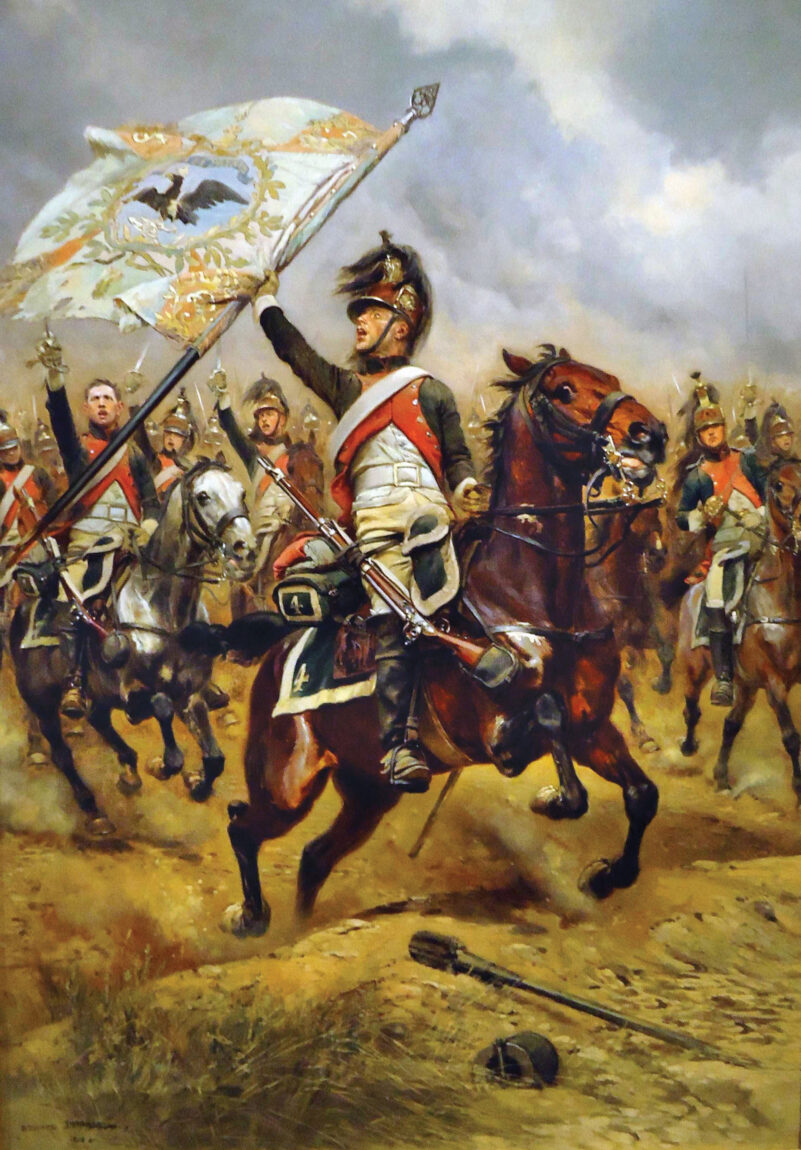
Around 11 am, both sides received reinforcements. Prince William of Orange advanced for Brunswick, and Morand for Davout. Orange split his brigade between both Prussian flanks, and Morand’s entire division took up positions on the French left. From there, Morand repulsed the horde of enemy cavalry south of Hassenhaussen that should have rounded the French left at least an hour before Morand’s arrival. Morand then secured that flank by extending his line to the River Saale.
Shortly after Morand sent the enemy horsemen packing, Davout seized the initiative and attacked, crushing Wartensleben’s men and then throwing back a counterattack by Orange, thus destroying the Prussian right. An effort to restore that part of the Prussian front with the remaining 14 infantry battalions, five cavalry squadrons, and three artillery batteries (about 9,000 men and 20 cannons) was never attempted.
the Liss Bach stream. There the French were charged by large numbers of enemy cavalry, but these were turned back by steady French musket fire from quickly formed squares. Dispirited by their inability to break the enemy’s squares, the Prussian troopers, soon followed by their equally demoralized and bloodied infantry cohorts, were forced back toward Auerstedt. Meanwhile, on the French right Friant, after a severe battle to take Poppel, finally captured the place along with 1,000 prisoners.
By noon, with both Prussian flanks about to collapse, the king ordered a retreat with the intention of joining Hohenlohe and Ruchel, whose forces he believed were intact. The final blow fell when Morand unlimbered an artillery battery, which raked the flank and rear of what remained of von Wartensleben’s command. The French guns’ devastating effect caused Wartensleben’s men to stream off the field in confusion to the west and north. In a vain attempt to cover the retreat of the rest of Brunswick’s shattered army, Blucher placed a rear guard in the path of the pursuing French. This was brushed away as the pursuers curled around both of Blucher’s flanks, sending his detachment running.
Davout continued his chase after the Prussians until 4:30 pm, when he ordered a halt due to the complete exhaustion of his men. The Prussians suffered 10,000 dead and injured, 3,000 taken prisoner, and 115 guns captured. The price paid by the III Corps amounted to 258 officers and 6,794 enlisted men dead or wounded.
After Auerstedt, Napoleon showered praise on Davout for his performance. That was not the case with Bernadotte, who had failed to come to Davout’s aid on October 14 despite the latter’s repeated plea for help and the emperor’s previous instructions to him to move in concert with III Corps. Bernadotte narrowly missed being court-martialed for his inexcusable conduct, most probably caused by sheer professional jealousy.
The twin battles of Jena-Auerstedt brought about the almost total destruction of Prussia’s field armies with the loss of over 28,000 dead and wounded and another 25,000 captured along with 200 artillery pieces. There would be additional battles fought and sieges conducted during the French rampage through Prussia over the next six weeks, all French victories—but Jena and Auerstedt clinched Napoleon’s ultimate conquest of Prussia and transformed the once powerful Hohenzollern state into a French vassal for the next six years.
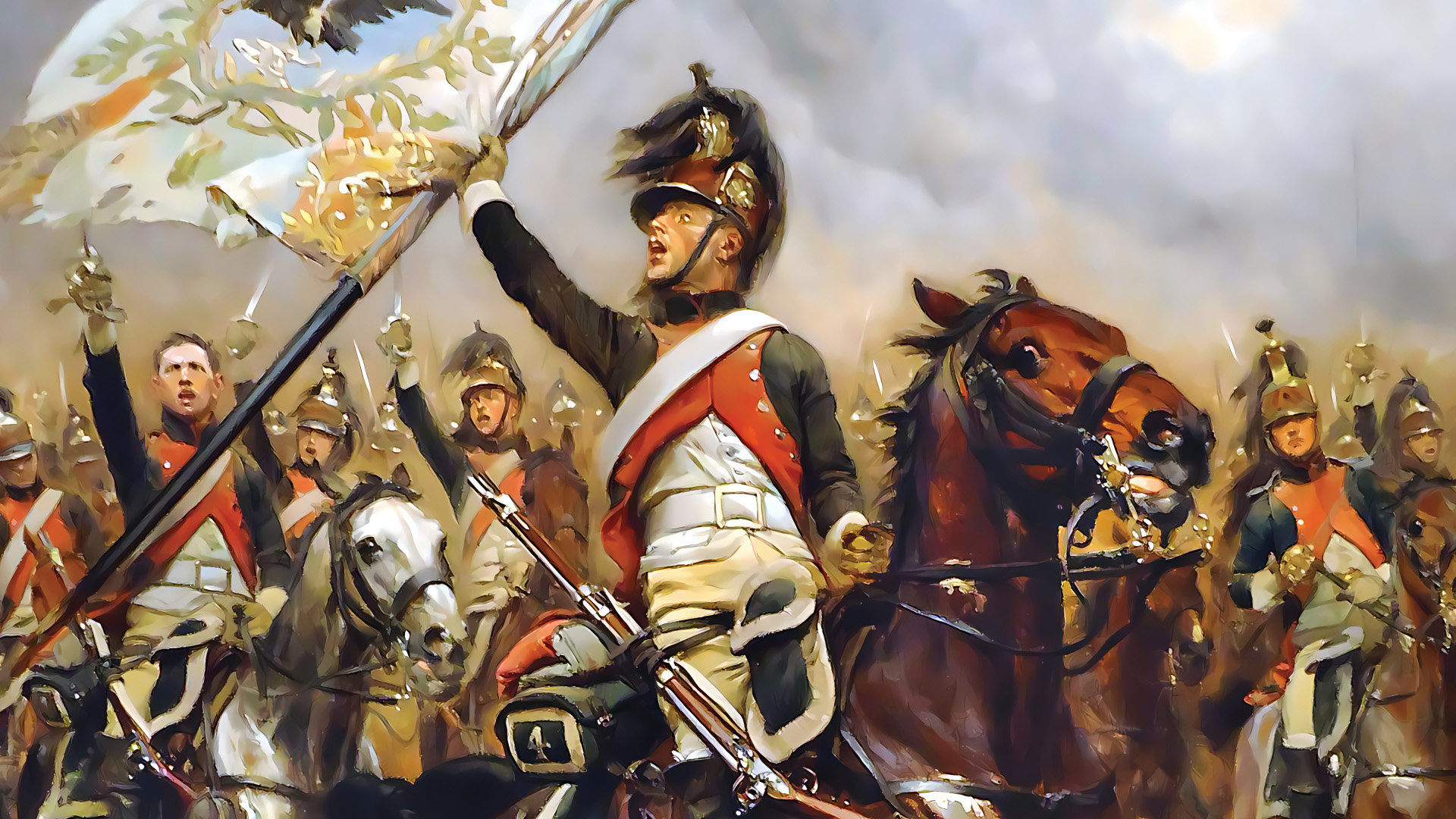
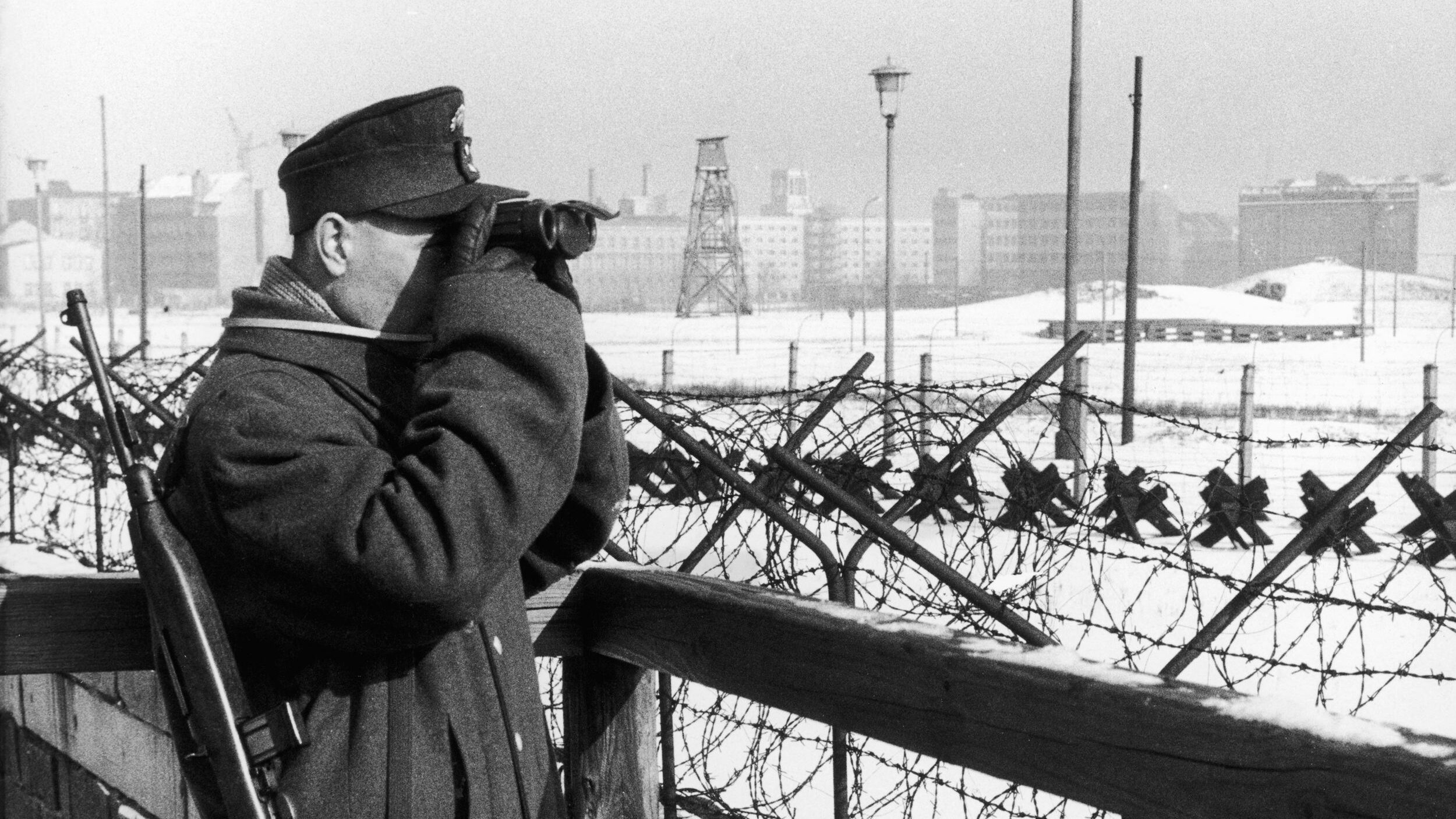
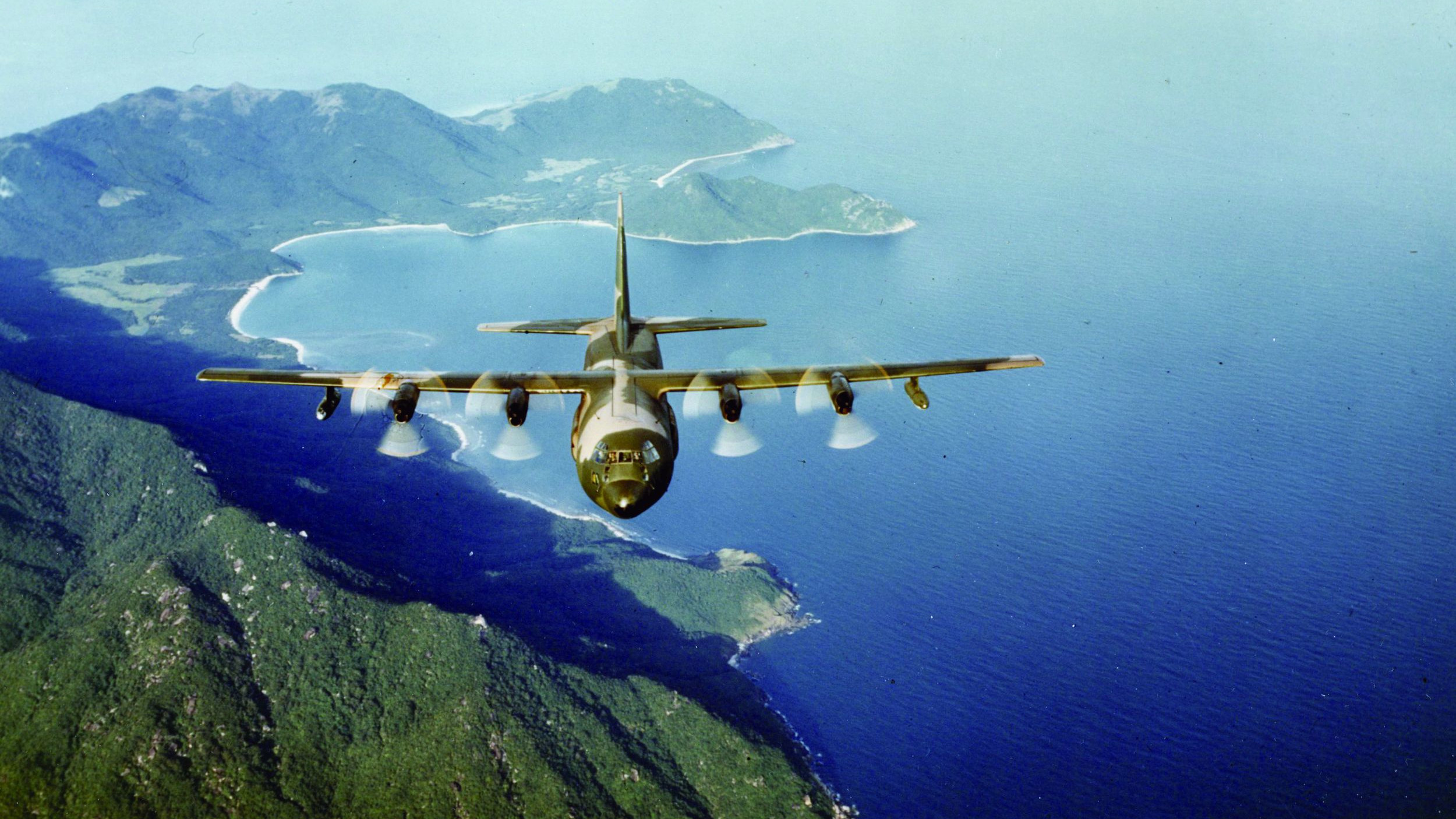
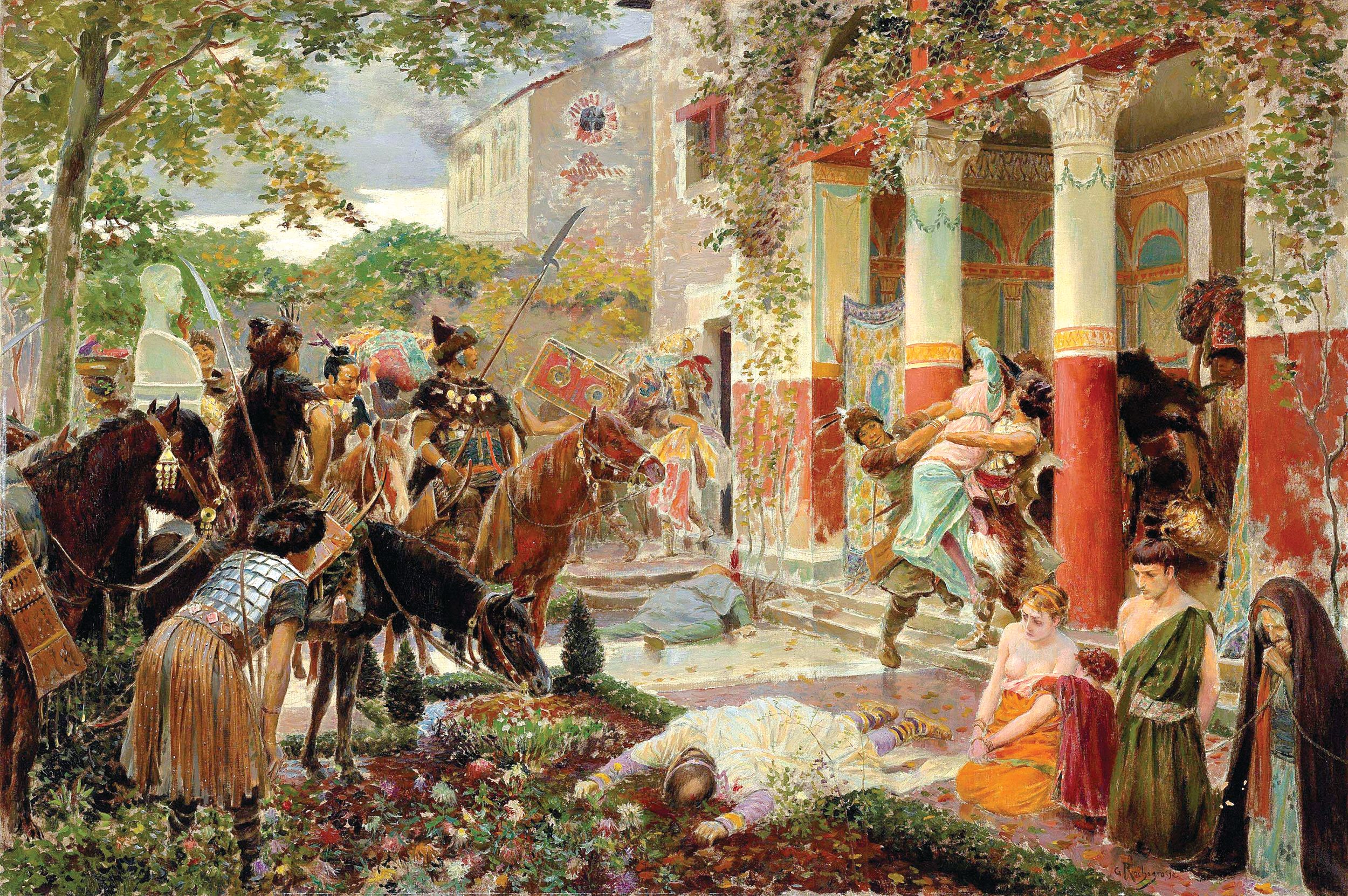
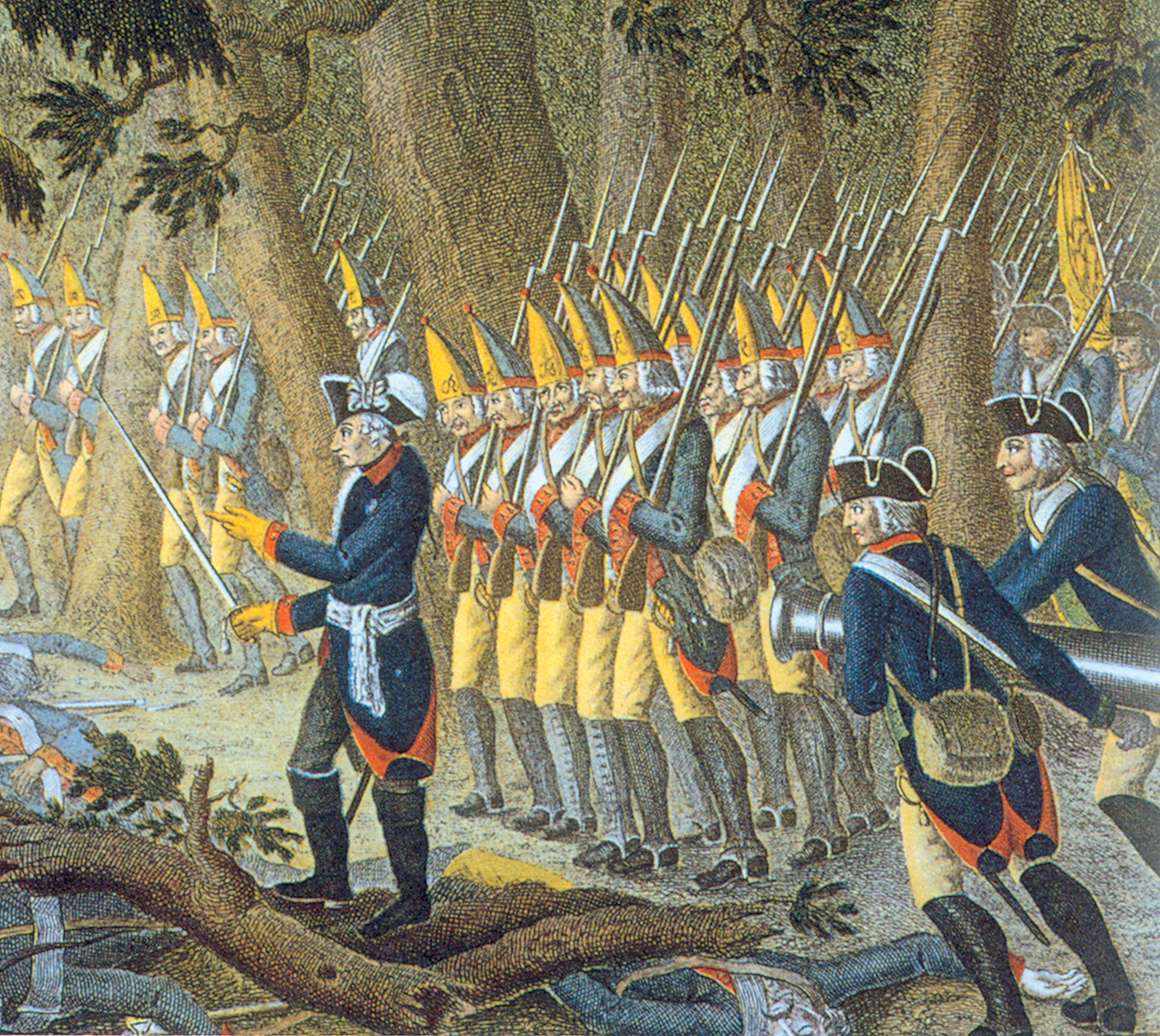
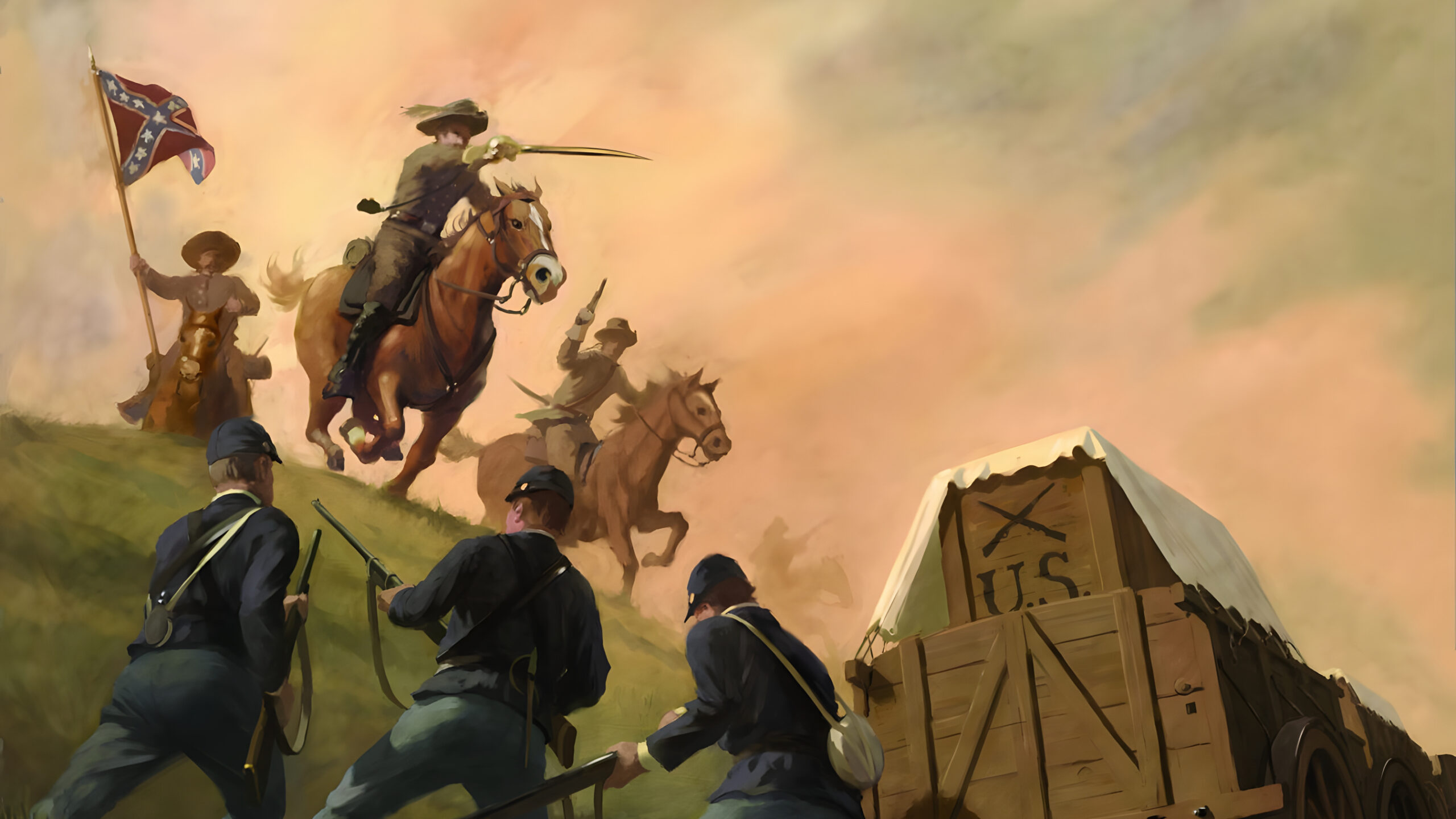

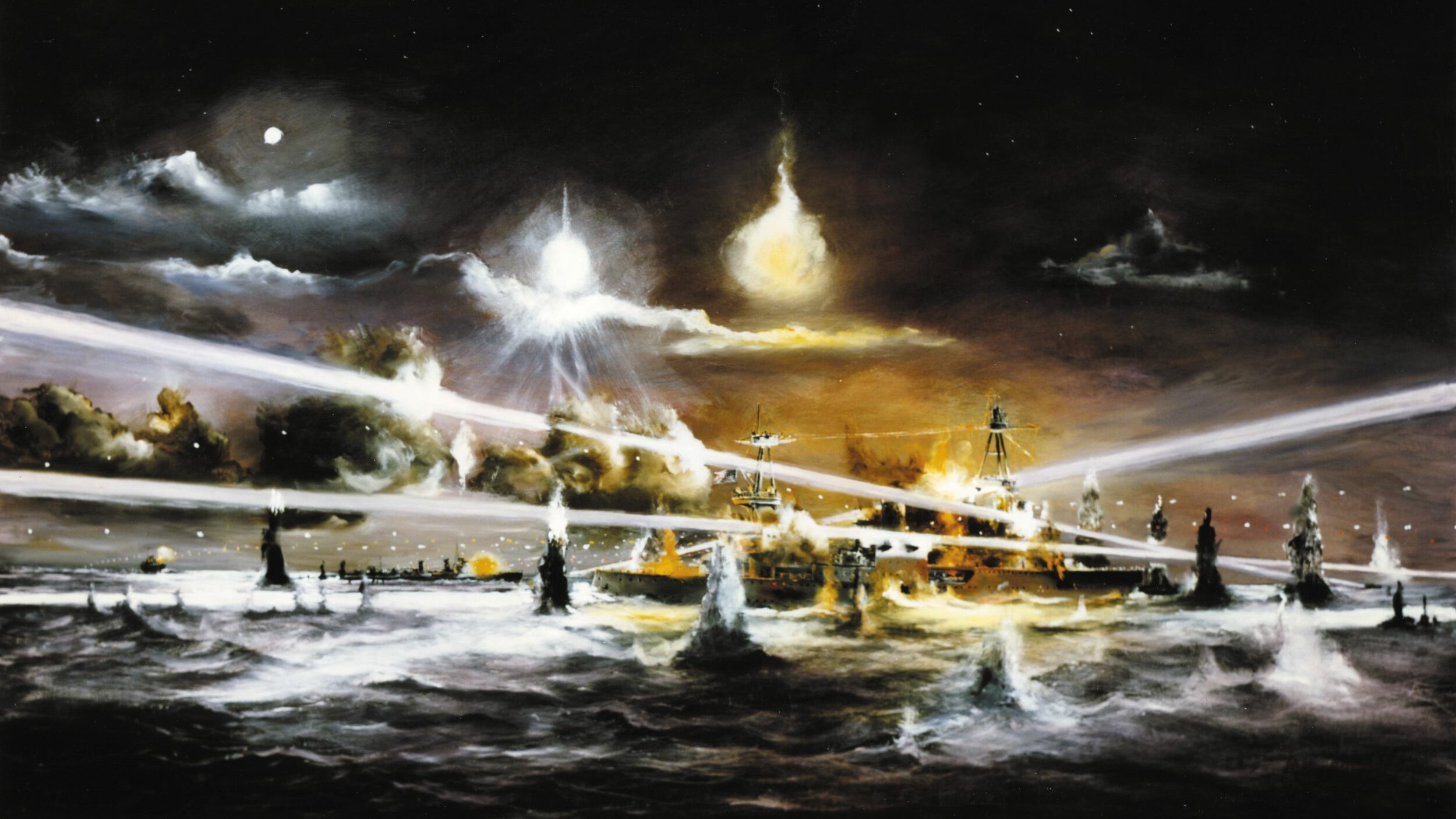
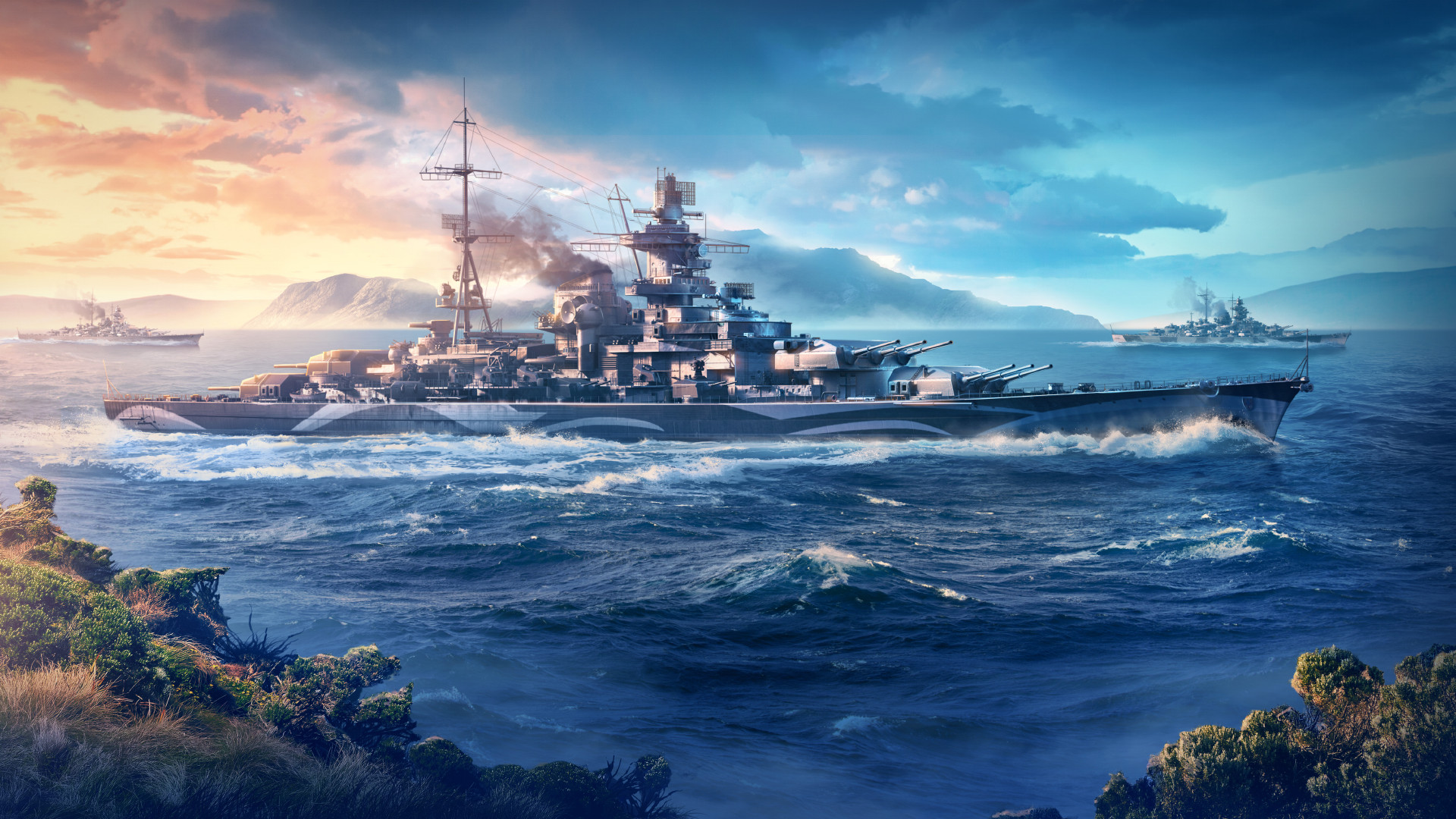
Join The Conversation
Comments
View All Comments